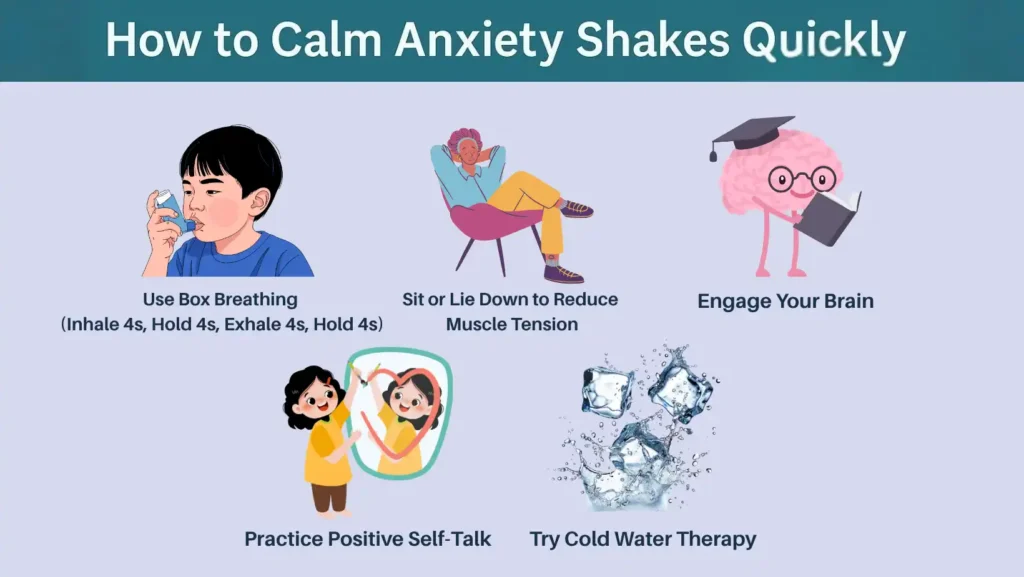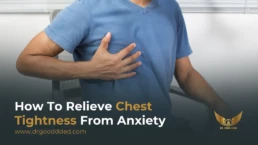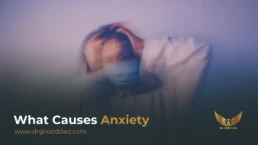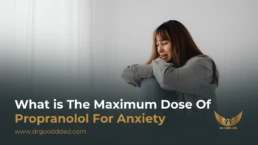Reducing the tremors that appear when your body reacts to stress helps stop shaking your body from anxiety. These shakes result from a surge of adrenaline and tension in muscles. They are not dangerous, but they can feel distressing.
Table of Contents
ToggleWhy Do I Shake When I Have Anxiety?
The Body’s “Fight or Flight” Response Explained
When you sense danger, the brain’s amygdala (a small region that detects threats) sends a signal to your adrenal glands. They release adrenaline and cortisol, two hormones that prepare you to fight or flee. This process is called the “fight or flight” response. Your heart beats faster, breathing quickens, and muscles tighten.
The same response can happen from emotional stress. That is why you shake when you have anxiety: your body believes it must take quick action even when no physical danger exists.
How Adrenaline Triggers Shaking and Trembling
Adrenaline increases muscle tension and blood flow to large muscles. Small stabilizing muscles then contract repeatedly. The rapid contractions cause tremors or shaking. Once the adrenaline fades, shaking gradually settles as the nervous system returns to balance.
Physical vs. Emotional Symptoms of Anxiety
Anxiety creates both mental and physical reactions. Emotionally, you might feel fear, dread, or restlessness. Physically, your body shows signs such as trembling, a fast heartbeat, sweating, dizziness, or tightness in the chest. Each sign connects through the same chemical chain that begins with adrenaline release.
Why Anxiety-Related Shaking Is Not Dangerous
Though unpleasant, shaking from anxiety is rarely harmful. The body uses shaking to release energy created by the stress response. These tremors typically fade within minutes once adrenaline levels drop. However, if the shaking continues for long periods or occurs without stress, medical evaluation is necessary.
What Anxiety Tremors Feel Like
Common Sensations — Trembling, Jitteriness, or Inner Shaking
Anxiety tremors vary. Some people experience visible trembling in their hands or legs, while others describe an internal vibration. You may feel your body tense and unsteady, as if it vibrates inside. These sensations come from overstimulated nerves and muscles.
Which Body Parts Are Affected (Hands, Legs, Voice, etc.)
Hands, arms, legs, and the voice are common areas affected. Fine motor muscles in the hands shake more visibly, while leg tremors appear when standing. Voice trembling happens when throat muscles tighten during stress.
How Long Does Anxiety Shake Usually Last?
Shakes from a short anxiety surge often last a few minutes to about 20 minutes. Once the situation passes and the body clears adrenaline, they lessen. Long-lasting tremors suggest persistent anxiety or another underlying trigger.
When Shaking Becomes a Chronic Symptom
Chronic tremors appear when anxiety remains high for weeks or months. Constant stress keeps the nervous system overactive. If trembling continues daily or without a visible cause, further evaluation is important to rule out other physical conditions.
Physical Causes vs. Anxiety Shaking
When Shaking Is Due to Caffeine, Medication, or Low Blood Sugar
Not all shaking results from anxiety. Stimulants like caffeine or nicotine speed up the nervous system, making hands shake. Some medications, such as asthma inhalers or antidepressants, have side effects that mimic anxiety tremors.
Low blood sugar (hypoglycemia) also triggers trembling, sweating, and weakness. Restoring glucose or adjusting stimulants often reduces these symptoms.
Distinguishing Anxiety Tremors from Neurological Conditions
Tremors linked to anxiety usually vary with stress levels and disappear during rest. Neurological tremors, such as in Parkinson’s disease or essential tremor, remain constant and may worsen with movement. A healthcare provider evaluates duration, pattern, and triggers to distinguish them accurately.
When to See a Doctor to Rule Out Other Causes
Consult a doctor if shaking lasts for hours, worsens over time, or includes weakness, balance problems, or speech difficulty. A medical review may include blood tests, medication history, and neurological assessment to ensure no other condition is present.
Calming Strategies to Stop Shaking from Anxiety
You can apply several techniques to calm the body and stop shaking from anxiety quickly and safely.
1. Deep Breathing Techniques to Slow Adrenaline Release
Controlled breathing stabilizes the nervous system. Try slow breathing: inhale through the nose for four seconds, hold for four seconds, exhale through the mouth for four seconds, then pause for four seconds. This “box breathing” slows heart rate, improves oxygen flow, and tells your brain to deactivate the stress response.
2. Grounding Methods (5-4-3-2-1 Sensory Technique)
The 5-4-3-2-1 technique uses your senses to bring focus back to the present. Identify five things you see, four things you touch, three things you hear, two things you smell, and one thing you taste. This method breaks the worry cycle that sustains anxiety tremors.
3. Relax Your Muscles Through Gentle Stretching
Stretching lowers muscle tension caused by adrenaline. Roll shoulders, extend arms, or bend knees slowly. The nervous system interprets these movements as signs of safety, reducing shaking naturally.
4. Use Mindfulness or Guided Meditation to Calm the Mind
Mindfulness (focused awareness of the present moment) slows anxious thought patterns. Listening to guided meditation reduces activity in brain regions that fuel the fight-or-flight response, easing both mental and physical agitation.
5. Keep Your Hands or Body Warm to Reduce Visible Tremors
Cold amplifies muscle vibration. Warming your hands or wearing layers helps prevent visible tremors, especially when anxious in public or cold environments.
6. Take Slow Sips of Water to Stabilize Your Body’s Response
Dehydration increases stress hormones. Drinking water in slow sips stabilizes internal balance and lowers the physical intensity of shaking.
7. Focus on One Movement — Tightening and Releasing Fists Helps
Clenching fists for a few seconds and then releasing them provides a physical outlet for tension. Repeating this pattern refocuses nerve activity away from uncontrolled trembling.
8. Avoid Caffeine, Nicotine, or Energy Drinks Before Stressful Events
These substances elevate adrenaline levels, intensifying shakes. Reducing or avoiding them before events like interviews or public speaking lowers tremor risk. This small change can help to stop shaking hands immediately during high-pressure moments.
How to Calm Anxiety Shakes Quickly

When symptoms appear suddenly, fast action helps shorten them.
Use Box Breathing (Inhale 4s, Hold 4s, Exhale 4s, Hold 4s)
Repetition of this pattern rebalances carbon dioxide and oxygen in the blood, slowing the body’s overreaction. This method works well for acute shaking episodes.
Sit or Lie Down to Reduce Muscle Tension
Sitting or lying limits gravity’s pull on tense muscles. Reducing strain lets muscles relax faster and diminishes tremor amplitude.
Engage Your Brain — Count Backward, Recite Lyrics, or Solve a Puzzle
Mental tasks redirect focus away from body sensations. The shift prevents anxiety from escalating, helping to calm anxiety shakes effectively.
Practice Positive Self-Talk (“This Is Anxiety, Not Danger.”)
Repeating accurate, calming thoughts reminds you that the shaking stems from anxiety, not threat. This reduces fear and speeds physical recovery.
Try Cold Water Therapy — Rinse Your Hands or Face Briefly
A brief splash of cold water activates the “diving reflex,” lowering heart rate and calming overactive nerves. This rapid cooling often cuts tremor intensity within seconds.
Ways to Control Anxiety Physically
Long-term improvement depends on strengthening your body’s resilience. These ways to control anxiety physically reduce future shaking episodes.
Get 7–8 Hours of Sleep Every Night
Sleep regulates cortisol and adrenaline. Inconsistent rest increases stress sensitivity. Regular sleep improves emotional stability and decreases physical reactivity.
Exercise Regularly to Balance Adrenaline and Cortisol
Physical activity burns excess stress hormones and raises endorphins (natural mood stabilizers). Even moderate daily exercise significantly lowers tremor frequency.
Eat Steady, Balanced Meals to Prevent Blood Sugar Drops
Stable blood sugar prevents body shakes caused by hypoglycemia. Include protein, complex carbohydrates, and healthy fats at regular intervals.
Maintain Good Posture to Improve Breathing Control
Slouching compresses your chest and restricts lung capacity. Upright posture supports full breathing, which prevents shortness of breath and limits anxiety symptoms.
Long-Term Solutions to Prevent Anxiety Shaking
Sustained relief requires addressing the root cause of anxiety.
Cognitive Behavioral Therapy (CBT) for Anxiety Response
CBT helps you identify negative thought patterns and replace them with rational interpretations. It trains your brain to respond calmly, which gradually reduces physical shaking.
Exposure Therapy to Reduce Triggers
Gradual exposure to feared situations desensitizes the nervous system. Over time, the body learns that these situations are not threats, decreasing tremor reactions.
Medication Options — SSRIs, Beta-Blockers, or Anti-Anxiety Drugs
SSRIs (selective serotonin reuptake inhibitors) balance serotonin, improving long-term anxiety control. Beta-blockers block adrenaline effects on muscles, controlling shaking. Short-term anti-anxiety drugs may be used for acute cases under medical supervision.
Relaxation-Based Lifestyle Habits (Yoga, Journaling, Mindfulness)
Consistent relaxation activities lower baseline anxiety levels. Yoga enhances body awareness, journaling clarifies stressors, and mindfulness reduces recurring tension cycles.
When to Seek Medical Help
Shaking from anxiety is common, but certain situations require medical assessment.
Shaking That Persists After Anxiety Passes
If tremors continue long after emotional stress ends, underlying medical causes must be excluded. Persistent shaking may signal other neurological or endocrine conditions.
Tremors Accompanied by Weakness or Dizziness
Weakness, dizziness, or changes in coordination are not typical anxiety signs. These warrant medical evaluation.
Symptoms Affecting Your Ability to Work or Perform Daily Tasks
If shaking prevents eating, writing, or daily functioning, professional treatment (psychological or medical) is strongly advised.
Signs of Panic Attacks or Hyperventilation Episodes
Rapid breathing, chest tightness, or numbness may indicate hyperventilation or panic disorder. Managing these early prevents long-term complications.
Frequently Asked Questions
Can anxiety make you shake for hours?
Yes. Continuous adrenaline output during prolonged stress can sustain anxiety with shaking for hours. If this happens often, professional therapy helps regulate your nervous system.
Is shaking a symptom of panic attacks?
Yes. Trembling is a core panic feature. During an attack, adrenaline peaks, producing visible and inner tremors. Learning how to calm anxiety shakes stops them faster.
Can breathing exercises really stop shaking?
Yes. Slow, deep breathing activates the body’s relaxation response, lowering adrenaline and reducing tremors. It remains one of the best methods to stop shaking from anxiety naturally.
What medications help calm anxiety tremors?
Doctors may use SSRIs for long-term control and beta-blockers for short-term relief. These reduce anxiety with shaking by targeting hormone and nerve pathways.

This article is medically reviewed by Dr. Chandril Chugh, Board-Certified Neurologist, providing expert insights and reliable health information.
Dr. Chandril Chugh is a U.S.-trained neurologist with over a decade of experience. Known for his compassionate care, he specializes in treating neurological conditions such as migraines, epilepsy, and Parkinson’s disease. Dr. Chugh is highly regarded for his patient-centered approach and dedication to providing personalized care.








